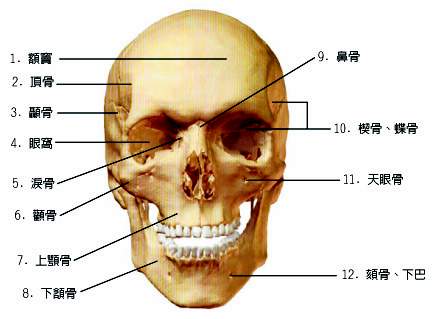
1. 固定的構音器官 Immobile articulators
包含了面骨、牙齒、硬顎、軟顎邊緣。而面骨和頭蓋骨構成了共鳴腔體重要的成分。牙齒也是重要成員之一。尤其當牙齒咬和不良時,便會導致發音不準的問題。其他的像硬顎和軟顎邊緣可稱作「上部發音器官」(the upper articulator),它們皆位於口腔上方的位置。
They are bones, teeth, hard palate, and alveolar ridge( the whole roof of the mouth). If there were no bones of the face and bones of the cranial skeleton, there would be no resonant cavities for speech production. Thus, bones are considered as basic components of immobile articulators. The teeth are also important members. Malocclusion results in problems in pronunciation. The other immobile articulators are termed, as ‘the upper articulators’ since most of them are located in the upper part of the oral cavity.
1.1顏面骨 Bones of face
藍色的數字可和下圖比對:
下頷骨 Mandible 8
上頷骨 Maxillae 7
鼻骨 Nasal Bone 9
顎骨和鼻甲 Palatine Bone and Nasal Conchae
犁骨 Vomer
顴骨 Zygomatic Bone 6
淚骨 Lacrimal bone 5
舌骨 Hyoid bone
1.2 顱部的骨架 Bones of the Cranial Skeleton
篩骨 Ethmoid Bone
蝶骨 Sphenoid Bone 10
額骨 Frontal Bone 1
顳骨 Temporal Bone 3
頂骨 Parietal Bone 2
枕骨 Occipital Bone


圖片摘自Seikel, et al. Anatomy and Physiology for Speech, Language, and Hearing
1.3 生齒 Dentition
牙齒長於上頷骨和下頷骨齒槽間,包含了門齒, 犬齒, 前臼齒, 臼齒( incisors, cuspids,bicuspids, and molars),每根牙齒都有齒根(root)和齒冠(crown),齒冠的表面由法瑯質和象牙質組成,而前者位於後者上方。
乳齒(deciduous arch)約在小孩六個月到九個月大時長出,至六歲到九歲時開此脫落,而恆齒( permanent arch)也在此時開始長出。
牙齒的閉合成三種型態:
第一類為正常的咬和,第二類是下頷骨內縮的咬和不良,就是俗稱的暴牙;相反的,第三類則是下頷骨突出的咬和不良,就是俗稱的厚道。
The teeth are housed within the alveoli of the maxillae and mandible, and consist of incisors, cuspids, bicuspids, and molars(門齒, 犬齒, 前臼齒, 臼齒). Each tooth has a root and crown , with the surface of the crown (齒冠) composed of enamel (法瑯質) overlying dentin.
Clinical eruption of the deciduous arch(乳齒) begins between 6 and 9 months of age, while the permanent arch (恆齒)emerge between 6 and 9 years.
There are three kinds of dental occlusion:
Class I occlusion refers to normal orientation of mandible and maxillae, while Class II malocclusion refers to a relatively retracted mandible. Class III malocclusion refers to a relatively protruded mandible.
1.4 發聲腔道 Cavities of the Vocal Tract
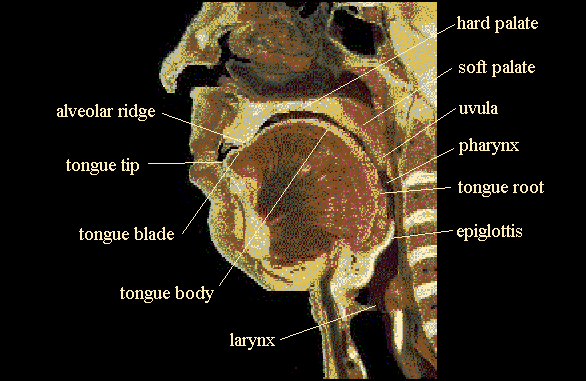
發聲腔道圖
圖片摘自(The Anatomy of Vocal Tract)http://www.umanitoba.ca/faculties/arts/linguistics/russell/138/sec1/anatomy.htm
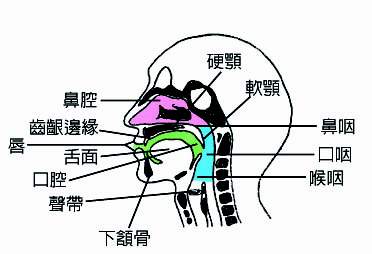
發聲腔道中文圖解
鼻腔 (Nasal cavity):是在軟顎上方的腔體,包含了整個鼻部和鼻咽。
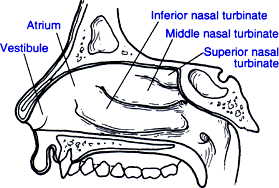
此圖摘自 http://ha.mtroyal.ab.ca/figs/l33/330300.htm
口腔 (Oral cavity):和兩頰兩側(buccal cavities)相接。為人體消化道的起點,為橢圓形的空腔。包括兩個部分:靠外側比較小的部分稱為口前庭(oral vestibule),內側較大,稱為口腔體(mouth cavity proper)。
(1)口前庭 (oral vestibule)
(2)口腔體 (mouth cavity proper)
(3)唇 (lips)
(4)頰 (cheeks)
(5)唇腺 (labial glands)
(6)頰腺 (buccal glands)
(7)齒齦 (gums, gingiva)
(8)牙槽突 (alveolar process)
(9)硬顎 (hard palate)
(10)軟顎 (soft palate)
(11)頰脂體 (corpus adiposum, buccal fat pad)
(12)翼突下頷縫 (pterygomandibular raphe)
(13)咀嚼肌 (muscles of mastication)—顳肌 (temporalis) ;咬肌 (masseters);內翼肌(internal pterygoid muscle) ;外翼肌 (external pterygoid muscle)
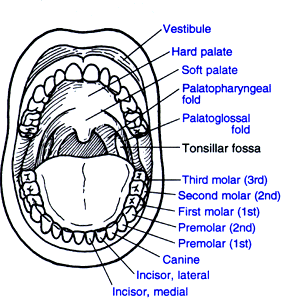
此圖摘自 http://ha.mtroyal.ab.ca/figs/l34/340100.htm
咽腔:咽腔位於鼻腔口腔後面,也是呼吸道及消化道為一相互交叉的地方,人體營養必須經此輸入,我國自古所謂咽喉要道,可知其重要性。
以上部分英文資料及圖片摘自Anatomy and Physiology for Speech, Language, and Hearing. (written by John A. Seikel, Douglas W. King, and David G. Drumright)
部分中文資料摘自張斌〈耳鼻喉科學〉